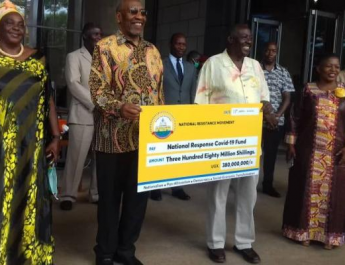The Executive Director of the National Social Security Fund (NSSF), Mr Richard Byarugaba, has warned that allowing a midterm access of the fund by members during coronavirus pandemic would signal the end of the social security scheme while having longterm ramifications on the economy.
On May 8, 2020, Speaker of Parliament Rebecca Kadaga gave the Finance and Gender Committees 10 days to examine the possibility of amending the NSSF Act to allow savers access 20% of their savings.
But as they discuss in the background, Byarugaba’s letter could significantly change their thinking.
But in a May 6 letter to Finance minister Matia Kasaija, Mr Byarugaba explains how the unprecedented initiative would not only ruin the Fund but also exert severe ramifications on the economy.
Below is Byarugaba’s letter to the finance minister
Background
Following the recent outbreak of COVID-19 in Uganda and its impacts on the economy, there are growing calls for NSSF to pay its members 20% of their accumulated balances.
It is reported that the recent closure of businesses to combat the spread of the virus is increasing unemployment and failure to service loan obligations.
Consequently, several commentators and some politicians have advocated for a 20% NSSF partial payment.
We believe this proposal has implications that will distress the sustainability of NSSF as a retirement scheme and the economy as a whole.
We discuss these implications.
THE IMPLICATIONS
LIQUIDITY
The immediate impact of the proposed payout will be an increased need for liquidity.
At a member’s fund value near UGX 13.0T, a 20% payout would represent UGX 2.6T.
In addition, the normal benefits payout for the financial year 2020/2021 is projected at UGX 800B.
As a result, total benefits payout in the next one year would translate into UGX 3.4T.
After a sustained period of good return performance, some retired members have been electing to leave their savings with the NSSF.
Accordingly, it can be assumed that some members may not withdraw their 20%—rendering the UGX 2.6T estimate exaggerated.
However, we maintain the UGX 2.6T estimate and instead raise the normal benefits payout to UGX 1.1T from UGX 800B.
This is because retired members who maintained their savings with NSSF could choose to take their money if the Fund’s financial performance falters.
Members above 55 years have a current balance of UGX 562B.
With a bad performance, there would be a run on the Fund similar to how banks bleed to death if savers learn that the bank’s financial position has weakened.
Therefore, we raise the estimate for next year’s total benefits payout to UGX 3.7T. We estimate member contributions for next year at UGX 1.2T, leaving the Fund with a liquidity requirement of UGX 2.5T excluding operating costs and contractual obligations.
This extra requirement of UGX 2.5T would have to come from the Fund’s investment portfolio through a sale of some assets, specifically treasury bonds.
The sale of assets
As indicated above, the Fund would have to sell its treasury bonds to meet benefits payments.
Assuming a fire sale across East Africa of UGX 2.5T, the damage to the markets cannot be understated.
Today, the Fund is the biggest holder (over 50%) and buyer of Government of Uganda bonds. If turned into a net seller, the NSSF would not be able to invest in new government bonds.
Consequently, the Government of Uganda would struggle to raise funds in its treasury auctions to fund its programs.
The muted demand for primary auctions would dramatically result into higher interest rates.
Relatedly, the Fund would struggle to find buyers in the secondary market unless the securities are heavily discounted and turmoil would arrive in the market place.
Secondly, ongoing real estate projects would be halted due to lack of liquidity or the NSSF could default on contracts.
The Fund is currently implementing long-term projects such as: Government Campus (UGX 853B), Pension Towers (UGX 3078), Lubowa Housing Estate (UGX 250B), Temangalo Housing Project (UGX 103B), Off taker project (UGX 23B) and Yusuf Lule Road (UGX 160B).
Interest rates, private sector credit and capital markets
With high interest rates available in government securities, banks would limit retail and corporate lending unless they were able to lend to the private sector at significantly higher rates.
Interest rates on existing loans would also be adjusted upwards and banks would be hit by non-performing loans.
This would hurt growth both in the short and medium term.
Hence, a 20% payout intended to spur the economy, damages it with its effects reaching members, non-members, the business community and the country at large.
The other view is that the NSSF only sells securities in the other East African markets.
Even if this were to happen, the Fund would still have to heavily discount its securities to entice buyers.
Additionally, the sales proceeds in foreign currency would be converted to UGX, which could lead to appreciation of the exchange rate thereby hurting exports.
Even then, the Fund would not invest in Government of Uganda bonds, which would still result into an increase in interest rates in Uganda.
On the equities, the NSSF holds over UGX 1.5T, with significant ownership in strategic companies like Umeme, DFCU, Stanbic, New Vision, CIPLA, Housing Finance Bank, Safaricom, KCB and Equity Bank.
The high interest rates would lower the valuation of these companies, making it difficult for them to raise money on the capital markets.
Consequently, in whatever form the Fund meets its liquidity requirements arising from this proposal, the economy would be severely hurt.
Members
It is important to take a deep dive into the membership of the NSSF.
The total membership of the Fund today is 2.3M, with a core membership of 1.2M.
Core members are those with balances on their accounts.
Of the 1.2M, 53% are active and 47% are dormant.
Active members include those that make at least one contribution in a year.
100,000 members or about 8.3% of the core members own 75% of the Fund.
About 1M active members (80%) have balances below UGX 10M and 7% have balances greater than UGX 50M.
Thus, this proposal will not address the wider need for a relief and yet it leaves irreparable damage on the economy and financial system.
Financial reporting
The proposal also bears financial reporting implications.
For justifiable reasons, the NSSF currently classifies its investments in bonds as held to maturity.
The sale of these securities would trigger a change of classification to either held for trading or available for sale.
Either classification would lead to marking to market of the fixed income portfolio at a time of increasing interest rates.
This would result into further losses to the remaining securities and consequently the Fund value and member balances.
Legal
In the recent ruling of David Chandi Jamwa Vs Uganda 2019, the Supreme Court dismissed Jamwa’s appeal for causing a financial loss when he sold bonds on the secondary market.
The precedent set by the judgement might suggest that NSSF should not sell bonds in the secondary market if the transaction were to result into a financial loss.
Yet this is the feasible route for funding the liquidity needs of this payout.
Conclusion and recommendations
As demonstrated above, this proposal not only ruins the NSSF but also has wider negative implications for the economy and society.
The Fund which has taken time to rebuild could collapse.
The underperformance of the Fund would make it less attractive to members, hurting private sector savings.
The Fund could face legal issues on its existing contracts.
The NSSF is an is key financial institution in Uganda’s economy with a long-term focus.
Trading this long-term focus for short-term fixes will have more lasting impacts on our economy.
Generally, the COVID-19 pandemic just strengthened an already existing plea by members for mid-term access to their savings.
We believe a position needs to be agreed upon in passing the proposed amendments of the NSSF Act.
This should allow for the introduction of new benefits relating to unemployment, medical, housing and education.
To fund the additional benefits, incentives need to be put in place to encourage additional savings beyond the standard 15% contribution.

The News Editor ,Reporter at Kagadi Kibaale community Radio




